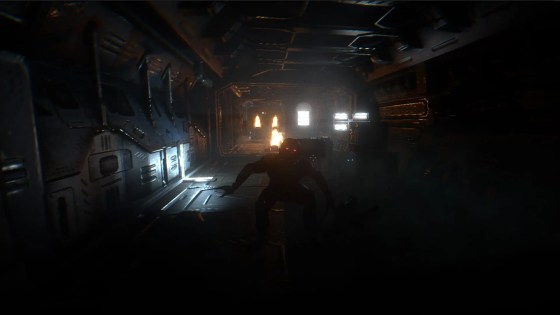I was about three hours into Syndrome when I realized that the alien monsters stalking the ship didn’t scare me anymore. It wasn’t because I got used to seeing so many of them, in fact, if there is anything the game does right is showing some level of restraint. The monsters lost their menace after a bigger fear grew within me. The fear that I might not have the patience to get through this game.
I think my patience started to waver as I discovered that Syndrome had very few original ideas. Like hundreds of survival horror games before it, you wake up from cryosleep to find most of the crew of your ship, the Valkenburg, dead. Those that have not been horrifically dismembered roam the ship as zombie-like mutations that want to do nothing but hit you with their robot arms. You have two people who are still alive and communicate with you through radio, telling you where to go and what to do like an obedient dog. You also pick up discarded diaries with one or two sentences giving a little bit of background to what happened on the ship. If you’ve played System Shock 2, Alien Isolation, and particularly Dead Space (to which this story treads uncomfortably close to), you have played Syndrome.
But I can forgive a rehashed story. What I can’t get over is just how poorly designed this game is. It has an infuriating gameplay loop that lasts for the almost ten hours of playtime. Someone tells you to go to a certain room, probably on a different deck than you are in. After you take the elevator there and traverse the mazelike level design, you finally get to your destination. The person over the radio will then tell you that you are missing and item and you have to go retrieve it on another deck. So you go back to the elevator and go to that deck. When you reach the place where the item is, there will likely be a monster for you to fight or a computer to hack. It is linear backtracking at its worst, and to add insult to injury it doesn’t even make sense within the game world. Sometime locked doors require a key, but other times they will simply be locked until the game unlocks them for you. The first twenty times you walk in front of that door it says it needs power. After you do a completely unrelated task in the ship, the door suddenly gains power and lets you in. There is a twist late in the plot that somewhat explains this but it does not give me back the hours backtracking throughout the damn ship.
There is also some semblance of combat but I ended up doing my best to avoid it near the end of the game. Not because it was difficult, but because it felt extremely floaty. You have a sort of space crowbar for melee attacks that has the worst block animation I have ever used and does minimal damage to most enemies. When you do get guns, I was positive they were firing Poggs from how underpowered they felt. There are monsters that can’t be beat with standard weapons and have to be avoided. They pull the old “they can only hear you” shtick but the game does some interesting things to vary up the gameplay. Doors opening will alert them as will walking too close to open air vents, as your character will cough and draw their attention. And while the standard grunt had an uninspired design, some of the bigger beasts were legitimately unnerving.
However, it seems most of the art budget was put into designing these monsters rather than crafting a unique environment. For an indie game, Syndrome looks fine, sporting some fancy post-processing effects and dramatic lighting. Yet, I felt as if I walked through these hallways before. If you have been on an abandoned spaceship in a video game before, you have seen everything Syndrome has to offer. There are also rooms that serve no purpose. Alien Isolation had these, but at least they made sense within the game world. The medical area had plenty of rooms, not all of them useful but it helps grounds the experience. The Valkenburg has rooms without items that seem to have no purpose. It really took me out of the experience.
And while the game might look passable, the sound design is simply atrocious. Some areas have little sounds that creep into your headphones and make you look certain ways when there is nothing there. And when a monster does show up, it roars like if it were in right in front of you, giving you no clue as to where it is in the environment. For a game so dependent on hearing where your enemy is, this is inexcusable. Even worse, there is no option to change the key bindings. I was stuck pressing C in order to sneak around, a cardinal sin in first person shooters. Then I would have to press F to pick up an item, while holding down C so I wouldn’t be spotted. The hand Twister I had to play probably added a few years to the inevitable arthritis heading my way.
Syndrome has an entire catalog of poor design choices that serve to do little more than frustrate the player. The constant backtracking left a permanent imprint of my hand on my face and the story gave me little reason to keep on playing. If Outlast is an example of how to do indie horror right, then Syndrome is the antithesis. Keep your distance, this one is infected.
- Some of the enemies looked kinda cool.
- Painful backtracking.
- Uninspired story.
- Combat felt way too floaty.







lady fashion japan movt quartz watch
http://www.forsining.com